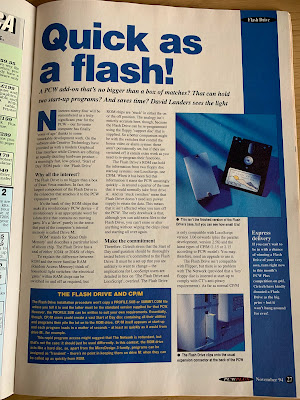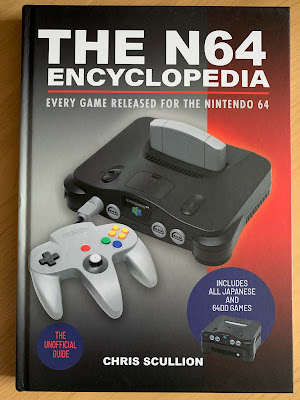For being one of the most prominent productivity computers for home users of the late 1980's, the Amstrad PCW never seems to get much appreciation. Released at a time when DOS PC's were a four figure purchase (unless you also went to Amstrad for those as well), the PCW became a success because it offered the basic office computer experience by bundling a printer and the software you needed for a very competitive price. Naturally, this led to dedicated publications, one of which was 8000 Plus. In 1992, Amstrad launched the 9000 series of the PCW range so the magazine changed its name to PCW Plus. Join me, then, on a quick look at two issues of this fine publication.
As I only have two issues of this magazine, March '92 and November '94, I may be missing out on the heyday of the format, but these still offer intriguing insights as to the state of the PCW market at the time of their publication and, perhaps more poignantly, demonstrate the decline of a format specific magazine.
The cover of March 92's issue headlines the way you can get music from your PCW. You might be surprised at this as the machine was launched with a focus purely on office productivity. Yet being a 256kb/516kb CP/M machine meant that it was much more than a word processor. The are also articles offering LocoScript advice, a guide to memory upgrades for owners of 256kb machines, and how to make the most of copy programs.
As befits the period, the cover is glossy and has a nice feel to it. The stock quality is also quite good, and although there is colour throughout, it is limited to specific features and adverts. Page count comes in at 84 including the covers. All that for £2.25.
The editorial is quite bullish when covering the news that Amstrad had made a trading loss. With the prospect of price cuts and possibly a higher level of ownership of the format, the editor believed the future looked bright. Never mind that this completely ignores the growing popularity and decreasing prices of the DOS PC but there you are - the editor seems very happy preaching to the converted. The news section that follows takes up three pages, and there are plenty of adverts too, yet throughout the magazine, I can only find a couple that are actually selling the new 9256/9512+ computers.
Ah, yes, the machine. A 9256 with a dot matrix printer would set you back around £400 inclusive, which wasn't too shabby even for 1992. 8086 PC's were still hovering around that mark excluding VAT and that didn't include a printer (and probably not any software either). The 9512+ with daisy wheel printer was about £500 inclusive, and the 9512+ with a Canon BJ10 inkjet was just over £600. The issue here that for £600, you could get an Amiga, Atari or a DOS set up with a printer. It might not be the best of specifications, but it would be more than a match for the Z80 in the Amstrads. By the end of the year, Acorn would have the A3010/3020 series out that would hover between the £500 and £700 mark, whilst even Apple would see sense and release the Mac Classic that would give you that famous single button experience for about £600 inclusive. You'd need to add a printer for those, but then you had the freedom of choice. Sad to say, one of the key selling points of the PCW in the 1980's (the cheap integrated package) had been superseded by faster and increasingly cheaper machines. But I digress.
It was lovely to see a column in PCW by Dave Langford, whose work in SFX magazine was always a good read, and I never knew he wrote for PCW Plus. The other features are well written and seem like they would have been useful to PCW owners.
Back to the adverts and there are quite a few, although I suspect this was the sum of PCW retailing at the time. There's plenty of software advertised, including a few games, although I believe the company selling the space saving desk on page 36 had been watching too much BBC sci-fi... Another thing to note is the sheer number of add-ons and improvements for the machines - external disk drives, ram packs, and interfaces.
 |
| Straight off the set of Star Cops... |
On to the November '94 issue, and it's here that we see the magazine epitomise the decline in the format.
The cover is still shiny but feels thinner than the one from '92. There seems to be more colour but the stock is also of lower quality. The cover price has increased to £2.95 yet the page count is down to 68 including the covers. Mr Langford is still present and there is a cracking feature on how to add flash storage to your PCW!
It is in the advertising that you really notice the difference. Sure, there are still many advertisers covering the format and its add-ons, and one that was still selling the 9000 series, although not the PCW10, which very much seems to have been the odd model out, despite being launched only the year before. A note on prices - the 9512+ had not changed in price since the March '92 issue. What was borderline competitive in then was massively over-priced by 1994.
Anyway, back to the advertising, and it's the inclusion of three adverts for PC's that stand out. One, from S.C.S. (not the sofa people) offers a 386SX 40MHz with 2MB of RAM, a 170MB hard drive and a 14-inch SVGA monitor for just £469 excluding VAT. You need to add DOS, Windows and a mouse to that (£70 ex VAT) for a total of ££539 ex VAT, or £630-ish inclusive. Source a printer from somewhere and you have a much faster, capable and expandable machine than any PCW. If you were spending several hundred pounds on a computer, you'd want a degree of longevity and even a 386 in 1994 offered that compared to a PCW.
 |
| The back cover - and that is NOT a PCW! |
It also highlights a sign that the magazine was in decline. It is a similar story to Amiga Format and Acorn User. Towards the end of their print lives, advertisers were covering anything from actual hardware to internet providers and the like (this was 2000 and 2003 respectively). Anything to fill the space in the mag and bring in the money. As far as mass market magazines went, the platforms were dying.
Confirming this are the Audit Bureau of Circulation figures. The '92 issue has the figures from January-June 1991, stating that an average of 27,186 copies were sold every month. The July-December '93 figures in the '94 issue is 16,335. I know that figures like that are pretty standard now, given the changes to the market and people's reading habits, but for the early 1990's, they were not looking good
As it was, time was running out for the PCW. Amstrad pulled the plug after the PCW10. Well, I say pulled the plug. There was the PcW16 launched in 1995 for £299 that was a last gasp for the name. It wasn't directly compatible and you couldn't use the floppy drive to run new programs. It was a sad way to end the PCW name. As for PCW Plus, it soldiered on until December 1996, which isn't bad considering the lack of hardware.
It's always cool reading format specific magazines from decades past (do you feel old yet?) as it gives you an look at how computing used to be before Windows cemented itself as the OS for the masses, MacOS survived long enough to hitch a ride on the iPhone business (only half joking there) and Chrome OS became the defacto Linux distribution(!). It's partly the reason why I love retro computing so much, the variety of machines and operating systems.
Would I want a PCW on my desk today? Hell, yes! Is there any chance of that? Not really, space and cost being the prime issues, but for the period they were around, they demonstrated that you could have practical, productive computing at a reasonable price, and a magazine such as PCW Plus is a perfect reminder of that.


























